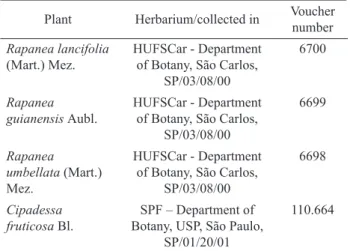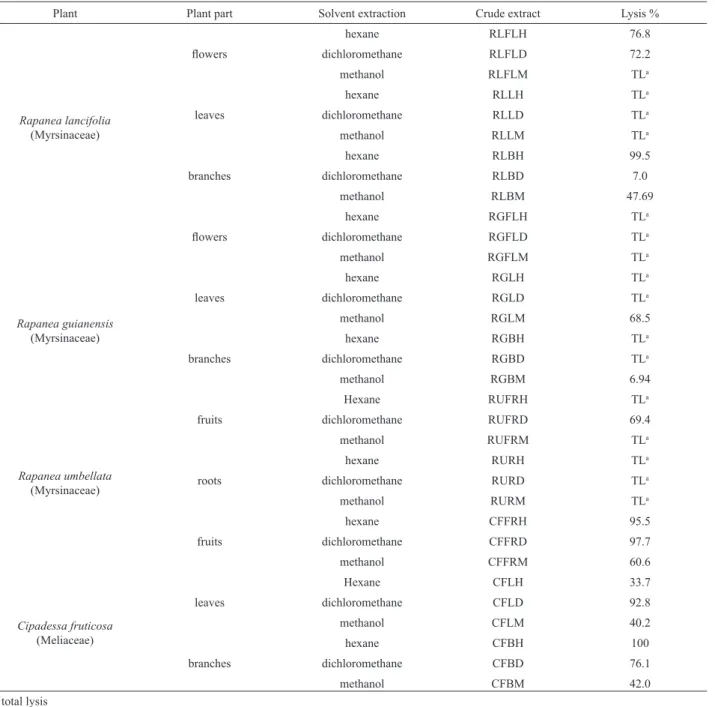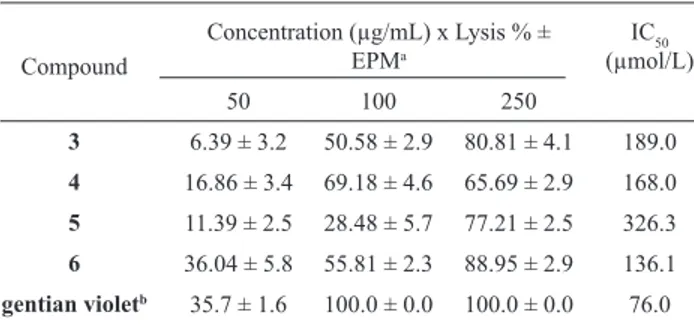RESUMO: “Atividade tripanocida de lavonoides e limonoides isolados de extratos ativos de plantas de Myrsinaceae e Meliaceae”. A atividade de extratos brutos de três espécies de Rapanea (Myrsinaceae) e de Cipadessa fruticosa (Meliaceae) foi avaliada in vitro contra formas tripomastigotas de Trypanosoma cruzi. Foram obtidos 33 extratos de diferentes órgãos das espécies estudadas, sendo que onze deles apresentaram atividades signiicantes (% de lise > 50) nos ensaios realizados. O fracionamento de um extrato ativo dos galhos de R. lancifolia (99,5%) resultou no isolamento de dois lavonoides (quercetina e taxifolina), que apresentaram baixa atividade tripanocida. De um extrato ativo dos frutos de C. fruticosa (97,7%) foram isolados os limonoides mexicanolídeos cipadesina, mexicanolídeo, febrifugina e cipadesina A, que foram moderadamente ativos sobre T. cruzi. Além disso, outros dois lavonoides (lavona e 7-metoxilavona), previamente ensaiados contra T. cruzi, foram isolados do extrato hexânico dos galhos de C. fruticosa (100%). Os resultados obtidos aqui sugerem que as plantas avaliadas podem constituir fontes de novas substâncias ativas sobre o T. cruzi.
Unitermos: Myrsinaceae, Meliaceae, atividade tripanocida, lavonoides, limonoides.
ABSTRACT:The activity of crude extracts of three Rapanea species (Myrsinaceae) and Cipadessa fruticosa (Meliaceae) was evaluated in vitro against the trypomastigote forms of Trypanosoma cruzi. Thirty-three extracts from different organs of these species were assayed and eleven of them showed signiicant activity (lysis % >50). The fractionation of an active extract from branches of R. lancifolia (99.5%) led to the isolation of two lavonoids: quercetin and taxifolin, which have weak trypanocidal activity. Additionally, one active extract from fruits of C. fruticosa (97.7%) afforded mexicanolide limonoids: cipadesin, mexicanolide, febrifugin and cipadesin A, that were slightly active on T. cruzi. Moreover, other two lavonoids (lavone and 7-methoxylavone), previously assayed against T. cruzi, were isolated from the hexane extract from branches of C. fruticosa (100%). The results presented here suggest that the plants evaluated could be a source of new active compounds against T. cruzi.
Keywords: Myrsinaceae, Meliaceae, trypanocidal activity, lavonoids, limonoids.
20(1): 1-6, Jan./Mar. 2010
Artigo
Received 16 April 2009; Accepted 29 October 2009
Trypanocidal activity of lavonoids and limonoids isolated from
Myrsinaceae and Meliaceae active plant extracts
Ana C. Leite,
1Artur Placeres Neto,
1Alessandra R. P. Ambrozin,
1João B. Fernandes,
1Paulo C. Vieira,
*,1Maria F. das G. F. da Silva,
1Sérgio de Albuquerque
21Departamento de Química, Universidade Federal de São Carlos, 13565-905 São Carlos-SP, Brazil 2Departamento de Análises Clínicas, Toxicológicas e Bromatológicas, Faculdade de Ciências Farmacêuticas
de Ribeirão Preto, Universidade de São Paulo, 14040-930 Ribeirão Preto-SP, Brazil
INTRODUCTION
Chagas’ disease (American trypanosomiasis) affects 16-18 million people, mostly from Central and South America, where 25% of the total population is at risk of infection (WHO, 2004). It is caused by a lagellate protozoan, Trypanosoma cruzi, and transmitted to humans by blood-sucking triatomine insects and by blood transfusion (WHO, 1997). With the control of the insect vector (Triatoma infestans), infected blood transfusion is becoming the major cause for the spread of the disease (Dias, 1993). The only trypanocidal substance currently
used to prevent the infection by this route is gentian violet, but its use is limited due to undesirable effects on the patients (Dias, 1993). The treatment of Chagas’ disease is still a challenge, since the only current available drug (benznidazole) has strong side effects (de Castro, 1993). Thus, the search for more eficient and less toxic drugs is needed to control this disease.
Guimarães & Faria, 2007). Several extracts from plants of Meliaceae and Rutaceae families have been showed in vitro activity against T. cruzi (Mafezoli et al., 2000; Vieira et al., 2001; Ambrozin et al., 2004; de Mesquita et al., 2005). Therefore, natural products constitute a promising source of new active compounds for treatment of Chagas’ disease.
In this paper, we report the results of the evaluation of in vitro trypanocidal activity of 33 crude extracts from different organs of Rapanea lancifolia, R. guianensis, R. umbelata Myrsinaceae, and Cipadessa fruticosa Meliaceae. Moreover, it is showed the trypanocidal activity of lavonoids isolated from hexane extracts from branches of R. lancifolia and C. fruticosa, as well the activity of four limonoids isolated from dichloromethane extract from fruits of C. fruticosa.
MATERIAL AND METHODS
Plant material
Plants were collected in different states of Brazil and identiied by Dr. Maria Inês Salgueiro Lima from Department of Botany, UFSCar, SP and Dr. José Rubens Pirani from Department of Botany, USP, SP (Table 1).
Table 1. Botanical identiication of plants assayed.
giving four fractions. Fraction 4 was fractionated in the same conditions to yield compounds 1 (3.2 mg) and 2 (3.7
mg).
The hexane extract (12.2 g) from branches of C. fruticosa (fresh weight: 1524 g) was submitted to vacuum liquid chromatography over silica gel using a hexane-CH2Cl2-EtOAc-MeOH gradient. The ethyl acetate fraction (6.8 g) was chromatographed on silica gel, eluting with hexane-CH2Cl2-acetone gradient to give nine fractions. Fraction 3 was fractionated as above, using hexane-CH2Cl2-acetone (6:3:1), affording nine fractions. Fraction 5 was three times chromatographed through column chromatography on silica gel, eluting with hexane-CH2Cl2 -MeOH (7:2.5:0.5) to afford compounds 7 (16.7 mg) and 8
(8.2 mg).
The dichloromethane extract from fruits (15.0 g) of C. fruticosa (fresh weight: 180 g), was submitted to vacuum liquid chromatography over silica gel using a hexane-CH2Cl2-EtOAc-MeOH gradient, resulting in the fractions: hexane-CH2Cl2 (1:1); CH2Cl2; CH2Cl2/AcOEt (1:1); EtOAc and EtOAc/MeOH (1:1). Fractions CH2Cl2/ AcOEt (1:1) and EtOAc/MeOH (1:1) were studied, as following described: the fraction CH2Cl2/AcOEt (1:1) (5.0 g) was again submitted to vacuum liquid chromatography on silica gel using a gradient elution (hexane, CH2Cl2, EtOAc, and MeOH), resulting in the four corresponding soluble fractions. The ethyl acetate fraction (2.3 g) obtained from the last fractionation was several times chromatographed on silica gel and inally submitted to preparative HPLC to afford for limonoids 3 (19.4 mg), 5 (8.1 mg), and 6 (8.5
mg). Limonoid 4 (48.9 mg) was isolated from fraction
EtOAc/MeOH (1:1) (4.6 g) of extract through several chromatographies on silica gel.
Compounds 1-6 were identiied through 1H and 13C NMR spectra, 1H - 1H COSY, HSQC and HMBC
experiments and MS. The spectral data of 1 and 2 were in
agreement with those published in the literature (Kuo et al., 1998; Moon et al., 2001) as well as the data of limonoids
3 (Luo et al., 2000), 4 (Paula, 1996), 5 (Govindachari &
Kumari, 1998) and 6 (Leite et al. 2005a). Additionally,
compounds 7 and 8 were characterized by comparison of
13C NMR data with the literature (Kingsburry & Looker, 1975). The in vitro activity on T. cruzi of compounds 3
- 6 is described herein. On the other hand, the activities of compounds 1, 2, 7 and 8 were previously reported
(Ambrozin et al., 2004; Tasdemir et al., 2006).
Bioassay
The bioassays were carried out according to the procedures described by Ambrozin et al. (2008). The activity of crude extracts was evaluated in triplicate at 4 mg/mL and pure substances at 250, 100, and 50 µg/ mL. It is expressed as percent reduction of the parasite number (lysis) and IC50 (µmol/L) for compounds 3-6 were calculated using the program GraphPad Prims v.3.0. Plant Herbarium/collected in Voucher
number
Rapanea lancifolia (Mart.) Mez.
HUFSCar - Department of Botany, São Carlos,
SP/03/08/00
6700
Rapanea guianensis Aubl.
HUFSCar - Department of Botany, São Carlos,
SP/03/08/00
6699
Rapanea umbellata (Mart.) Mez.
HUFSCar - Department of Botany, São Carlos,
SP/03/08/00
6698
Cipadessa fruticosa Bl.
SPF – Department of Botany, USP, São Paulo,
SP/01/20/01
110.664
Extraction and isolation of compounds
The powdered air-dried plant material was extracted three times (72 h) by maceration with hexane, CH2Cl2 and MeOH at room temperature. The solvent was removed under reduced pressure by rotary evaporation and the extracts obtained were assayed against T. cruzi.
RESULTS AND DISCUSSION
In this work, we assessed the trypanocidal activity of 33 extracts of three Myrsinaceae and one Meliaceae species (Table 2). Eleven of them (33%) showed signiicant activity (lysis % > 50) at 4 mg/mL against the trypomastigote forms of T. cruzi. The majority of the extracts of C. fruticosa presented relevant activity. The best result was obtained from the hexane extract from branches of C. fruticosa (CFBH) that reduced 100% of the parasite number. The majority of the extracts of the three Rapanea species assayed did not present signiicant results, since several extracts led to the total lysis of the parasites and the red blood cells, as well. However, some extracts of these species showed high trypanocidal activity
without affecting the red blood cells, such as the hexane extract from branches of R. lancifolia (RLBH).
Similar studies involving the trypanocidal activity of Meliaceae and Rutaceae species have been reported by our group (Mafezoli et al., 2000; Vieira et al., 2001; Ambrozin et al., 2004, 2005a, 2008) showing that these plants can be considered a promising source of active compounds against trypomastigote forms of T. cruzi. Thus, the signiicant results obtained from the extracts of C. fruticosa are consistent with those previously reported for this family.
The investigation of the methanol fraction of the active hexane extract from branches of R. lancifolia (RLBH) led to the isolation of the lavonol quercetin (1)
Plant Plant part Solvent extraction Crude extract Lysis %
Rapanea lancifolia (Myrsinaceae)
hexane RLFLH 76.8
lowers dichloromethane RLFLD 72.2
methanol RLFLM TLa
hexane RLLH TLa
leaves dichloromethane RLLD TLa
methanol RLLM TLa
hexane RLBH 99.5
branches dichloromethane RLBD 7.0
methanol RLBM 47.69
hexane RGFLH TLa
lowers dichloromethane RGFLD TLa
methanol RGFLM TLa
Rapanea guianensis (Myrsinaceae)
hexane RGLH TLa
leaves dichloromethane RGLD TLa
methanol RGLM 68.5
hexane RGBH TLa
branches dichloromethane RGBD TLa
methanol RGBM 6.94
Hexane RUFRH TLa
fruits dichloromethane RUFRD 69.4
Rapanea umbellata (Myrsinaceae)
methanol RUFRM TLa
hexane RURH TLa
roots dichloromethane RURD TLa
methanol RURM TLa
hexane CFFRH 95.5
fruits dichloromethane CFFRD 97.7
methanol CFFRM 60.6
Cipadessa fruticosa (Meliaceae)
Hexane CFLH 33.7
leaves dichloromethane CFLD 92.8
methanol CFLM 40.2
hexane CFBH 100
branches dichloromethane CFBD 76.1
methanol CFBM 42.0
Table 2.In vitro activity of the crude extracts (4 mg/mL) of Rapanea species and Cipadessa fruticosa on trypomastigote forms of Trypanosoma cruzi.
and the dihydrol avonol taxifolin (2). Several biological activities have been reported for these l avonoids. Quercetin
(1), for example, presented antiprotozoal effect against Plasmodium falciparum (IC50 = 14 µM), Trypanosoma brucei brucei (IC50 = 13.2 µM), Leishmania donovani (IC50 = 63.8 µM) (Camacho et al., 2002), T. brucei and T. rhodesiense (Williamson & Finnigan, 1978). In addition, this compound was described as a constituent of an aqueous extract from Lychnophora pinaster, Asteraceae which showed trypanocidal activity (Silveira et al., 2005). Recently, high leishmanicidal activity was described for such compound (Tasdemir et al., 2006). Compounds 1 and 2 were previously
assayed on trypomastigote forms of T. cruzi, but showed low activity (Tasdemir et al., 2006). The relevant activity of the original extract (RLBH) is probably associated with the presence of other compounds or mixture of them.
The mexicanolide limonoids 3-6, isolated from fruits of C. fruticosa, showed signii cant trypanocidal activity (Table 3). They were obtained from the very active dichloromethane extract of fruits (Table 2, CFFRD, 97.7 %). This extract also afforded other limonoids (Leite et al., 2005a,b), which were not assayed herein. Recently, we reported the inhibitory activity of crude extracts of Meliaceae and Rutaceae plants on glycosomal glyceraldehyde-3-phosphate dehydrogenase (gGAPDH) enzyme from T. cruzi. The results showed that crude
The trypanocidal activity of lavone (7) and
7-methoxylavone (8), isolated from the active hexane
extract from branches of C. fruticosa (CFBH), was previously published by Ambrozin et al. (2004). They showed that these lavonoids, isolated from an active fraction of Conchocarpus heterophyllus (Rutaceae), presented low activity against trypomastigote forms of T. cruzi (IC50 = 2116 and 787 µg/mL or 9531 and 1084 µmol/L, respectively) when compared with other lavonoids (Ribeiro et al., 1997; Ambrozin et al., 2004). Probably, the relevant activity obtained from the extract CFBH can be related to other characteristic metabolites of C. fruticosa. As limonoids in the present work showed trypanocidal activity, we believe that the activity of CFBH extract may be associated with these compounds.
Table 3. In vitro activity of cipadesin (3), febrifugin (4), mexicanolide (5), and cipadesin A (6) on trypomastigote forms of Trypanosoma cruzi.
In conclusion, the present study showed that
Compound
Concentration (µg/mL) x Lysis % ± EPMa
IC50
(µmol/L)
50 100 250
3 6.39 ± 3.2 50.58 ± 2.9 80.81 ± 4.1 189.0
4 16.86 ± 3.4 69.18 ± 4.6 65.69 ± 2.9 168.0
5 11.39 ± 2.5 28.48 ± 5.7 77.21 ± 2.5 326.3
6 36.04 ± 5.8 55.81 ± 2.3 88.95 ± 2.9 136.1
gentian violetb 35.7 ± 1.6 100.0 ± 0.0 100.0 ± 0.0 76.0
a medium standard error b positive control
the Myrsinaceae and Meliaceae plants constitute a potential source of active compounds for treatment of Chagas’ disease. The phytochemical study of three active extracts of R. lancifolia and C. fruticosa led to the isolation of quercetin (1), taxifolin (2), lavone (7) and
7-methoxylavone (8), which had showed weak activity
against the trypomatigote forms of T. cruzi, and cipadesin (3), febriguin (4), mexicanolide (5), and cipadesin A (6)
that were appreciably actives. In addition, the trypanocidal activity of plants of Myrsinaceae family and limonoids 3-6 are been disclosed for the irst time.
ACKNOWLEDGEMENTS
The authors are grateful to Fundação de Amparo à Pesquisa do Estado de São Paulo (FAPESP), Conselho Nacional de Desenvolvimento Cientíico e Tecnológico (CNPq), Coordenação de Aperfeiçoamento de Pessoal de Ensino Superior (CAPES) and Financiadora de Estudos e Projetos (FINEP) for the inancial support. Also, authors thanks to Dr. Maria Inês Salgueiro Lima, and Dr José Rubens Pirani for identiicating the investigated plants.
REFERENCES
Ambrozin ARP, Leite AC, Silva M, Vieira PC, Fernandes JB, Thiemann OH, da Silva MFGF, Oliva G 2005b. Screening of Leishmania APRT enzyme inhibitors. Pharmazie 60: 781-784.
Ambrozin ARP, Mafezoli J, Vieira PC, Fernandes JB, da Silva MFGF, Ellena JA, de Albuquerque S 2005a. New pyrone and quinoline alkaloid from Almeidea rubra and their trypanocidal activity. J Braz Chem Soc 16: 434-439. Ambrozin ARP, Vieira PC, Fernandes JB, da Silva MFGF, de
Albuquerque S 2004. Trypanocidal activity of Meliaceae and Rutaceae plant extracts. Mem Inst Oswaldo Cruz 99: 227-231.
Ambrozin ARP, Vieira PC, Fernandes JB, da Silva MFGF, de Albuquerque S 2008. Piranolavonas inéditas e atividades tripanocidas das substâncias isoladas de Conchocarpus heterophyllus. Quim Nova 31: 740-743.
Camacho MD, Phillipson JD, Croft SL, Marley D, Kirby GC, Warhurst DC 2002. Assessment of the antiprotozoal activity of Galphimia glauca and the isolation of new nor-secofriedelanes and nor-friedelanes. J Nat Prod 65: 1457-1461.
de Castro SL 1993. The challenge of Chagas’ disease chemotherapy: an update of drugs assayed against Trypanosoma cruzi. Acta Trop 53: 83-98.
de Mesquita ML, Desrivot J, Bories C, Fournet A, de Paula JE, Grellier P, Espindola LS 2005. Antileishmanial and trypanocidal activity of Brazilian Cerrado plants. Mem Inst Oswaldo Cruz 100:783-787.
Dias JCP 1993. Transfusional Chagas disease in Brazil. Mem Inst Oswaldo Cruz 88: 63-65.
Duschak VG, Couto AS 2007. An insight on targets and patented drugs for chemotherapy of chagas disease. Recent Patents Anti-Infect Drug Disc 2: 19-51.
Govindachari TR, Kumari GNK 1998. Tetranortriterpenoids from Khaya senegalensis. Phytochemistry 47: 1423-1425. Guimarães DAS, Faria AR 2007. Natural compounds with
anti-Trypanosoma cruzi activity. Rev Bras Farmacogn 17: 455-465.
Kingsburry CA, Looker JH 1975. Carbon-13 spectra of methoxylavones. J Org Chem 40: 1120-1124.
Kuo Y, Yeh M, Huang S 1998. A novel 6-butyl-3-hydroxylavanone from heartwood of Bauhinia purpurea. Phytochemistry 49: 2529-2530.
Leite AC, Ambrozin ARP, Castilho MS, Vieira PC, Fernandes JB, Oliva G, da Silva MFGF, Thiemann OH, Lima MIS, Pirani JR 2009. Screening of Trypanosoma cruzi glycosomal glyceraldehyde-3-phosphate dehydrogenase enzyme inhibitors. Rev Bras Farmacogn 19: 1-6. Leite AC, Bueno FC, Oliveira CG, Fernandes JB, Vieira PC, da
Silva MFGF, Bueno OC, Pagnocca FC, Hebling MJA, Bacci Jr M 2005b. Limonoids from Cipadessa fruticosa and Cedrela issilis and their insecticidal activity. J Braz Chem Soc 16:1391-1395.
Leite AC, Fernandes JB, da Silva MFGF, Vieira PC 2005a. Limonoids from Cipadessa fruticosa. Z Naturforsch B 60: 351-355.
Luo XD, Wu SH, Ma YB, Wu DG 2000. Components of Cipadessa baccifera. Phytochemistry 55: 867-872. Mafezoli J, Vieira PC, Fernandes JB, da Silva MFGF, de
Moon J, Tsushida T, Nakahara K, Terao J 2001. Identiication of quercetin 3-O-β-D-glucuronide as an oxidative metabolite
in rat plasma after oral administration of quercetin. Free Radical Bio Med 30: 1274-1285.
Paula JR 1996. Estudo itoquímico do enxerto de Cedrela odorata
sobre Toona ciliata (Meliaceae). São Carlos. Tese de doutorado, Programa de Pós-graduação em Química, Universidade Federal de São Carlos.
Ribeiro A, Veloso DP, Romanha AJ, Zani CL 1997. Trypanocidal lavonoids from Trixis vauthieri. J Nat Prod 60: 836-838.
Serrano SM, Nogal JJ, Díaz RAM, Escario JA, Fernández ARM, Barrio AG 2000. In vitro screening of American plant extracts on Trypanosoma cruzi and Trichomonas vaginalis. J Ethnopharmacol 71: 101-107.
Silveira D, Wagner H, Chiari E, Lombardi JA, Assunção AC, de Oliveira AB, Raslan DS 2005. Biological activity of the aqueous extract of Lychnophora pinaster Mart. Rev Bras Farmacogn 15: 294-297.
Tasdemir D, Kaiser M, Brun R, Yardley V, Schmidt TJ, Tosun F, Ruedi P 2006. Antitrypanosomal and antileishmanial activities of lavonoids and their analogues: in vitro, in vivo, structure-activity relationship, and quantitative structure-activity relationship studies. Antimicrob Agents Ch 50: 1352-1364.
Vieira PC, Mafezoli J, Pupo MT, Fernandes JB, da Silva MFGF, de Albuquerque S, Oliva G, Pavão F 2001. Strategies for the isolation and identiication of trypanocidal compounds from the Rutales. Pure Appl Chem 73: 617-622.
WHO 1997. World Health Organization, Weekly Epidemiological Record 1. Geneve.
WHO 2004. World Health Organization Division of Control of Tropical Diseases at http://www.who.int/ctd/chagas/ disease.htm, accessed on May 2004.


